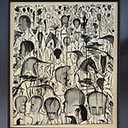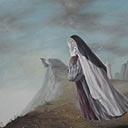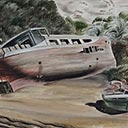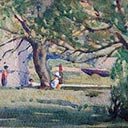Art Lover 3
111.5 x 95 cm
Since 1991 when Bill Hammond (b.1947) repatriated the bird spirits from the Southern Oceans to the Mainland the ominous nature of an Avian waiting pervades his work. Whether passively as in Waiting for Buller (1994) where preserved birds are draped across a table; or aggressively in All Along the Heaphy Highway (1999) where a gang of giant birds sits on a hill watching a lonely and threatened car drive past far below; the sense that hooked bill and claw wait for a time of vengeance lies only thinly veiled below the surface of these and many other works.
The importance of the artist's visit to the Auckland Islands, 320 kilometres south of Stewart Island, as a participant in the "Art in the Sub Antarctic" project is well-rehearsed. The experience was a revelation and opened a new romantic-gothic path for the artist. In an interview with Gregory O'Brien for Lands and Deeds (Godwit, Auckland, 1996), Hammond described the islands as a kind of lost world, ruled over by beak and claw: "The Auckland Islands are like New Zealand before people got here. It's bird land [….] It's a beautiful place, but it's also full of ghosts, shipwrecks, death."
The 1990s was also a haunted and tumultuous time; and perhaps the artist's gradual processing of his experience of the Auckland Islands served as metaphor for a new decade of "ghosts, shipwrecks, death." For the 1990s was also a time of loss and of waiting with uncertainty as the structures of the cold war unravelled; the internet emerged to give millennial apocalypse a new twist; the AIDS crisis ballooned; and progressive culture was under siege as strident neo-conservatives achieved success in shutting down exhibitions and museums. As a litmus paper of the time, it is no wonder Hammond's 1990s works resonate with foreboding. Even in Art Lover 3 Hammond's birds - here with appropriated human bodies - wait with unsettling composure. Whether they wait for judgement day to see ripe justice meted out to those who brought about their extinction, or, for some of their own to return from haunted wandering, or, more whimsically for another art star to rise into their firmament, they exist in a kind of limbo. Spaced apart so as to fill the picture plane with as little overlapping as possible, and rendered in profile, they can remind us of other pictorial limbos: old-fashioned museum displays and printed sales catalogues. Equally their monochrome shapes recall the way paper-and-scissors silhouette portraitists make folk art specimens of their subjects. In the Lover series of 1997, Hammond has transferred the same schemes waiting, spacing and profiles - to round-headed, puffball-coiffed and horse-headed people. Rob Garrett February 2015





